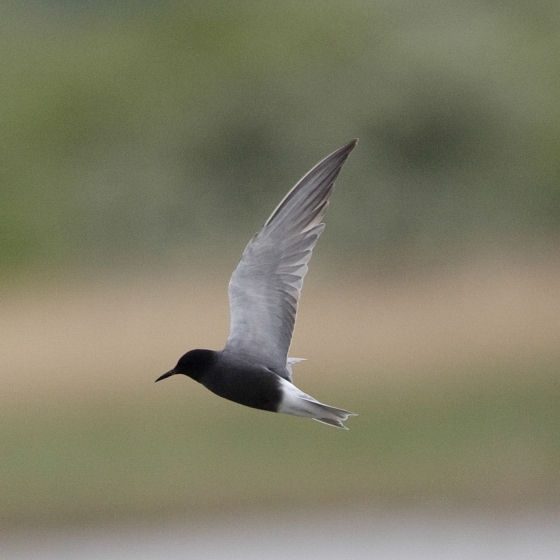Black Tern

Introduction
This delicate marsh tern once nested in Britain in large colonies, but these disappeared as wetland areas were drained; it is now an annual visitor from Europe.

Key Stats
Identification
Songs and Calls
Call:
Status and Trends
Conservation Status
Population Size
Population Change
Black Tern was an abundant breeding bird in East Anglia and elsewhere in southern and eastern England until the middle of the 19th century [Parkin & Knox 2010]. The last confirmed breeding record was from Nottingham in 1978 and the species is now classed as a former breeder [Stanbury et al. 2024]. Black Tern occurs regularly across the UK as a passage migrant, particularly in the spring; influxes can occur when easterly winds force birds further west on their return to continental breeding grounds [Balmer et al. 2013]. During autumn migration, sightings tend to be more coastal and more likely from the south and east [Parkin & Knox 2010]. The surinamensis race, which breeds in Canada and the northern USA and winters in South America, is a very rare visitor to the UK; one female has been recorded in an Arctic Tern colony in Northumberland since 2020 – it bred with an Arctic Tern in 2024 [Bacon et al. 2024].
Distribution
Black Terns are regular migrants and large spring influxes can occur if birds heading to continental breeding grounds are forced west by easterly winds. Passage birds were widely recorded during the 2007–11 breeding atlas. Black Terns last bred in Britain in 1978 and in Ireland in 1975.
Occupied 10-km squares in UK
or view it on Bird Atlas Mapstore.
or view it on Bird Atlas Mapstore.
European Distribution Map
Distribution Change
Change in occupied 10-km squares in the UK
or view it on Bird Atlas Mapstore.
or view it on Bird Atlas Mapstore.
Seasonality
Black Tern is a regular passage migrant in late spring and autumn.
Weekly pattern of occurrence
The graph shows when the species is present in the UK, with taller bars indicating a higher likelihood of encountering the species in appropriate regions and habitats.

Movement
Britain & Ireland movement
European movements
EuroBirdPortal uses birdwatcher's records, such as those logged in BirdTrack to map the flows of birds as they arrive and depart Europe. See maps for this species here.
The Eurasian-African Migration Atlas shows movements of individual birds ringed or recovered in Europe. See maps for this species here.
Biology
Productivity and Nesting
Nesting timing
Egg measurements
Clutch Size
Survival and Longevity
Survival is shown as the proportion of birds surviving from one year to the next and is derived from bird ringing data. It can also be used to estimate how long birds typically live.
Biometrics
Wing length and body weights are from live birds (source).
Ring Size
Classification, names and codes
Classification and Codes
- Order: Charadriiformes
- Family: Laridae
- Scientific name: Chlidonias niger
- Authority: Linnaeus, 1758
- BTO 2-letter code: BJ
- BTO 5-letter code: BLATE
- Euring code number: 6270
Alternate species names
- Catalan: fumarell negre
- Czech: rybák cerný
- Danish: Sortterne
- Dutch: Zwarte Stern
- Estonian: mustviires
- Finnish: mustatiira
- French: Guifette noire
- Gaelic: Steàrnag-dhubh
- German: Trauerseeschwalbe
- Hungarian: kormos szerko
- Icelandic: Kolþerna
- Irish: Geabhróg Dhubh
- Italian: Mignattino comune
- Latvian: melnais zirinš
- Lithuanian: juodoji žuvedra
- Norwegian: Svartterne
- Polish: rybitwa czarna
- Portuguese: trinta-réis-negro / gaivina-preta
- Slovak: corík cierny
- Slovenian: crna cigra
- Spanish: Fumarel común
- Swedish: svarttärna
- Welsh: Corswennol Ddu
- English folkname(s): Carr Swallow, Blue Darr

